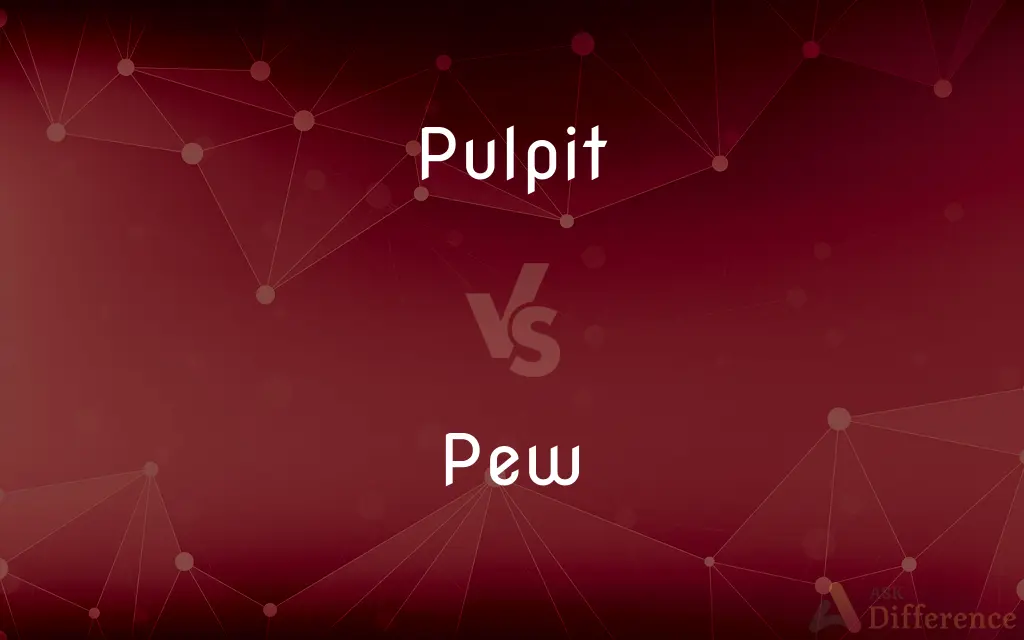Pulpit vs. Pew — What's the Difference?
By Tayyaba Rehman & Maham Liaqat — Updated on March 13, 2024
Pulpits are raised platforms in churches used by clergy to deliver sermons, whereas pews are long benches for congregational seating.

Difference Between Pulpit and Pew
Table of Contents
ADVERTISEMENT
Key Differences
Pulpits serve as the focal point in churches for preaching and leading worship, traditionally elevated to symbolize the authority of the clergy and the Word of God. Pews, on the other hand, are designed for the congregation's comfort during services. Originating in the medieval period, pews have evolved from simple wooden benches to sometimes being intricately carved and fitted with cushions and book holders.
While pulpits emphasize the delivery of religious teachings, pews focus on the congregation's experience of worship. The presence of pews in a church reflects the importance of the laity's role in worship, providing a space for communal prayer and reflection. The design and arrangement of pews can also reflect a church's theological and liturgical priorities, such as a focus on communal worship or individual reflection.
Despite their different functions, both pulpits and pews play integral roles in the worship experience. The pulpit serves as a bridge between the clergy and the congregation, facilitating the transmission of religious teachings, whereas pews provide a space for the congregation to receive these teachings and participate in communal worship. The relationship between the pulpit and pews in a church reflects the dynamic interplay between religious leadership and laity in the Christian tradition.
The interplay between pulpit and pew symbolizes the dialogue between clergy and congregation, highlighting the communal nature of worship. While the pulpit represents the source of spiritual guidance, pews embody the collective faith and receptivity of the worshippers, creating a physical and symbolic space for the enactment of religious rituals and teachings.
Comparison Chart
Primary Use
Delivering sermons and leading worship
Seating for the congregation
ADVERTISEMENT
Symbolism
Authority of clergy and the Word of God
Community and participation in worship
Design
Often elevated and ornate
Long benches, sometimes with cushions/book holders
Location in Church
Near the front, facing the congregation
Arranged facing the pulpit/front of the church
Influence on Worship
Facilitates preaching and teaching
Influences congregation's participation and comfort
Compare with Definitions
Pulpit
A raised platform or lectern in a church from which the sermon is delivered.
The pastor ascended the pulpit to begin his sermon.
Pew
A long bench with a back, used for seating members of a congregation.
The family sat together in the same pew they've used for years.
Pulpit
Used in metaphoric sense for a position of advocacy.
The activist used her platform as a pulpit to speak on environmental issues.
Pew
Can denote a specific family’s seating area in historical contexts.
The plaque on the pew marked it as reserved for the town's founding family.
Pulpit
A platform for clergy to lead worship.
From the pulpit, the minister led the congregation in prayer.
Pew
Part of church furniture focusing on congregational comfort.
The new cushions on the pews were appreciated by the congregation.
Pulpit
Symbol of religious authority and preaching.
The new pulpit, made of oak, symbolized the church's rich history.
Pew
Reflects the importance of the laity in worship.
The arrangement of the pews encouraged more engagement from the congregation.
Pulpit
The focal point for delivering religious messages.
The congregation turned their attention to the pulpit as the service began.
Pew
Symbolizes a place for communal worship and reflection.
The empty pews during the weekday held silent stories of Sundays past.
Pulpit
A pulpit is a raised stand for preachers in a Christian church. The origin of the word is the Latin pulpitum (platform or staging).
Pew
A pew () is a long bench seat or enclosed box, used for seating members of a congregation or choir in a church, synagogue or sometimes a courtroom.
Pulpit
A raised enclosed platform in a church or chapel from which the preacher delivers a sermon
Many ministers delivered political guidance from their pulpits
Pew
One of the long, fixed, backed benches that are arranged in rows for the seating of a congregation in church.
Pulpit
A raised platform in the bows of a fishing boat or whaler.
Pew
An enclosed compartment in a church that provides seating for a number of people, such as a family.
Pulpit
An elevated platform, lectern, or stand used in preaching or conducting a religious service.
Pew
One of the long benches in a church, seating several persons, usually fixed to the floor and facing the chancel.
In many churches some pews are reserved for either clerical or liturgical officials such as canons, or for prominent families.
Pulpit
Clerics considered as a group.
Pew
An enclosed compartment in a church which provides seating for a group of people, often a prominent family.
Pulpit
The ministry of preaching.
Pew
Any structure shaped like a church pew, such as a stall, formerly used by money lenders, etc.; a box in a theatre; or a pen or sheepfold.
Pulpit
An elevated metal guardrail extending around the bow or stern of a yacht or other small vessel.
Pew
A chair; a seat.
Pull up a pew.
Pulpit
An elevated platform, such as one used by harpooners in a whaling boat.
Pew
To furnish with pews.
Pulpit
A bully pulpit.
Pew
An expression of disgust in response to an unpleasant odor.
Pulpit
A raised platform in a church, usually enclosed, where the minister or preacher stands when giving the sermon.
Pew
Representative of the sound made by the firing of a gun.
Pulpit
Activity performed from a church pulpit, in other words, preaching, sermons, religious teaching, the preaching profession, preachers collectively or an individual preaching position; by extension: bully pulpit.
Pew
One of the compartments in a church which are separated by low partitions, and have long seats upon which several persons may sit; - sometimes called slip. Pews were originally made square, but are now usually long and narrow.
Pulpit
A raised desk, lectern, or platform for an orator or public speaker.
Pew
Any structure shaped like a church pew, as a stall, formerly used by money lenders, etc.; a box in theater; a pen; a sheepfold.
Pulpit
(nautical) The railing at the bow of a boat, which sometimes extends past the deck. It is sometimes referred to as bow pulpit. The railing at the stern of the boat is sometimes referred to as a stern pulpit; other texts use the term pushpit.
Pew
To furnish with pews.
Pulpit
A bow platform for harpooning.
Pew
Long bench with backs; used in church by the congregation
Pulpit
A plane's cockpit.
Pulpit
An elevated place, or inclosed stage, in a church, in which the clergyman stands while preaching.
I stand like a clerk in my pulpit.
Pulpit
The whole body of the clergy; preachers as a class; also, preaching.
I say the pulpit (in the sober useOf its legitimate, peculiar powers)Must stand acknowledged, while the world shall stand,The most important and effectual guard,Support, and ornament of virtue's cause.
Pulpit
A desk, or platform, for an orator or public speaker.
Pulpit
Of or pertaining to the pulpit, or preaching; as, a pulpit orator; pulpit eloquence.
Pulpit
A platform raised above the surrounding level to give prominence to the person on it
Common Curiosities
Why are pews important in churches?
Pews are important for providing seating for the congregation, facilitating their participation in worship services.
What is the main function of a pulpit?
The main function of a pulpit is to serve as a platform from which the clergy can deliver sermons and lead worship.
Can the design of pews affect a worship service?
Yes, the design and arrangement of pews can influence the congregation's engagement and comfort during worship.
What does the pulpit symbolize in a church?
The pulpit symbolizes the authority of the clergy and the importance of the Word of God in worship.
Is the pulpit always located at the front of the church?
Generally, the pulpit is at the front facing the congregation, but its exact location can vary by church architecture.
How do the designs of pulpits and pews differ?
Pulpits are often elevated and ornate, symbolizing authority, while pews are designed as long benches, prioritizing congregational comfort.
Are pews always made of wood?
Historically, pews are mostly made of wood, but modern materials may also be used for comfort and durability.
How have pews evolved over time?
Pews have evolved from simple benches to more comfortable seating with cushions and book holders, reflecting changes in worship practices.
Can the placement of pews affect the acoustics of a church?
Yes, the arrangement and materials of pews can impact the acoustics, influencing how sound travels during services.
Can anyone speak from the pulpit?
Typically, only ordained clergy or authorized speakers deliver messages from the pulpit.
How does the pulpit reflect the theological priorities of a church?
The design and prominence of the pulpit can indicate the importance placed on preaching and the authority of scripture in the church.
Why might a church choose bench pews over individual chairs?
Bench pews can enhance a sense of community and tradition, and may also be more aesthetically in line with the church’s architecture.
Are there modern alternatives to traditional pews in churches?
Some churches opt for chairs or movable seating to allow flexible arrangements for different types of services and events.
What materials are used for pulpits?
Pulpits are commonly made from wood, but stone, metal, and modern materials are also used.
Do all churches have pews?
While most churches have pews, some modern or non-traditional churches may use chairs or other seating arrangements.
Share Your Discovery

Previous Comparison
Earthenware vs. Terracotta
Next Comparison
Revelatory vs. RevealingAuthor Spotlight
Written by
Tayyaba RehmanTayyaba Rehman is a distinguished writer, currently serving as a primary contributor to askdifference.com. As a researcher in semantics and etymology, Tayyaba's passion for the complexity of languages and their distinctions has found a perfect home on the platform. Tayyaba delves into the intricacies of language, distinguishing between commonly confused words and phrases, thereby providing clarity for readers worldwide.
Co-written by
Maham Liaqat














































